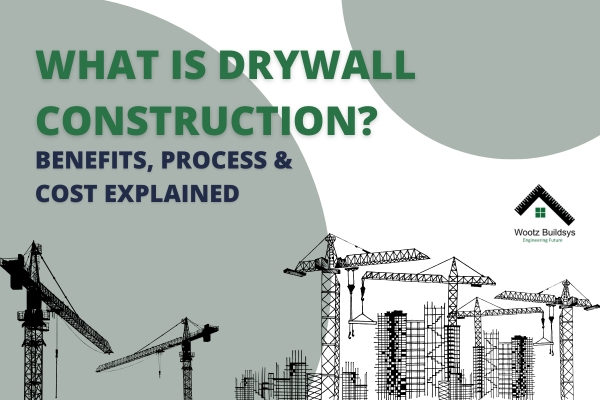
Drywall Construction
In the modern construction industry, drywall construction has become a popular choice for residential, commercial, and industrial buildings. Also known as gypsum board or plasterboard, drywall provides a smooth, durable, and efficient alternative to traditional plaster and masonry walls.
Whether you’re planning a new build or renovating an existing structure, understanding drywall construction can help you make informed decisions regarding time, cost, aesthetics, and energy efficiency. In this blog, we will explore what drywall construction is, its benefits, how it’s installed, and what it typically costs—along with expert answers to common questions.
What Is Drywall Construction?
Drywall construction refers to the method of creating interior walls and ceilings using pre-manufactured panels made primarily of gypsum (calcium sulfate dihydrate) sandwiched between two layers of paper. These panels are cut, fitted, and fastened to framing members—such as metal or timber studs—to form smooth wall surfaces ready for painting, tiling, or wallpapering.
Drywall is lightweight, easy to work with, and ideal for partitioning spaces quickly and cleanly. It has become the standard for interior wall finishing in modern buildings due to its affordability and versatility.
Types of Drywall Used in Construction
There are several types of drywall, each suited for different applications:
- Regular (White Board): Most commonly used for general interiors.
- Moisture-Resistant (Green Board): Ideal for bathrooms and kitchens.
- Fire-Resistant (Type X): Used in areas requiring fire-rated assemblies.
- Soundproof Drywall: Thicker and layered for sound dampening.
- Mold-Resistant Drywall: Treated to prevent mold and mildew in humid areas.
- Foil-Backed Drywall: For vapor barrier protection in cold climates.
Benefits of Drywall Construction
Drywall offers numerous advantages over conventional construction methods:
1. Speed of Installation
Drywall can be installed much faster than brick-and-mortar walls or plastering, drastically reducing construction timelines.
2. Cost-Effective
Compared to traditional methods, drywall is relatively inexpensive in terms of both material and labor.
3. Lightweight
Drywall panels are easy to handle and place, reducing structural load and simplifying transportation and storage.
4. Aesthetic Versatility
Drywall allows for smooth finishes and can be easily painted, wallpapered, or decorated. It also enables modern designs like recessed lighting and curved walls.
5. Sound and Thermal Insulation
When combined with insulation materials, drywall improves energy efficiency and acoustic performance in buildings.
6. Fire Resistance
Fire-rated drywall can help contain fires, providing critical protection in residential and commercial buildings.
7. Environmentally Friendly
Drywall is recyclable, and many products are manufactured using sustainable processes or post-consumer materials.
Drywall Construction Process: Step-by-Step
Here’s a detailed look at how drywall is typically installed:
Step 1: Framing the Walls
- The layout is marked.
- Metal or timber studs are erected to form the framework.
Step 2: Electrical & Plumbing Work
- Before drywall installation, all internal wiring, plumbing, and HVAC components are completed.
Step 3: Measuring & Cutting Drywall Sheets
- Sheets are cut to size using utility knives or saws.
- Holes are made for switches, sockets, and fixtures.
Step 4: Installing the Drywall
- Sheets are screwed or nailed to the studs using drywall screws or nails.
- Seams between panels are aligned carefully.
Step 5: Taping and Joint Compound
- Joint tape and compound are applied to all seams and fasteners.
- Multiple coats are added for a smooth finish, with sanding between coats.
Step 6: Finishing
- After drying, the surface is sanded and primed for paint or wallpaper.
Step 7: Painting or Decoration
- Final wall treatments are applied to match the desired aesthetic.
Cost of Drywall Construction
The cost of drywall construction can vary depending on factors such as:
- Location
- Wall height and complexity
- Type of drywall used
- Labor costs
- Finishing materials
Estimated Cost Breakdown (India – 2025 prices):
| Type | Cost (Per Sq. Ft.) |
| Regular Drywall | ₹60 – ₹90 |
| Moisture-Resistant | ₹80 – ₹110 |
| Fire-Resistant | ₹100 – ₹130 |
| Soundproof | ₹120 – ₹180 |
Applications of Drywall Construction
Drywall is suitable for a wide variety of applications:
- Residential homes (living rooms, bedrooms, ceilings)
- Commercial buildings (offices, retail, lobbies)
- Healthcare facilities (clean and sterile environments)
- Educational institutions (classrooms and labs)
- Hotels and hospitality (quick refurbishment)
Limitations of Drywall
While drywall is a fantastic construction option, it has some limitations:
- Not load-bearing (cannot support structural loads)
- Can be damaged by impact or moisture (unless using the right type)
- Requires skilled labor for proper joint finishin
Conclusion
Drywall construction is an efficient, cost-effective, and flexible solution for interior spaces in both residential and commercial buildings. It’s fast to install, easy to maintain, and environmentally friendly. Whether you’re building from scratch or renovating, drywall offers design freedom without compromising structural performance.
Frequently Asked Questions (FAQs)
Q1. Is drywall suitable for Indian climate conditions?
Yes, drywall works well in Indian climates, especially when moisture-resistant or mold-resistant panels are used in humid regions like coastal areas or kitchens.
Q2. How long does drywall construction take?
A typical 1000 sq. ft. interior drywall job can be completed in 3–5 days, including installation, joint finishing, and surface preparation—much faster than conventional brick walls.
Q3. Can drywall be used for ceilings as well?
Absolutely. Drywall is widely used for false ceilings and suspended ceiling systems. It allows integration with lighting, air conditioning vents, and sound systems.
Q4. How durable is drywall?
Standard drywall is durable for general use but can dent or crack under impact. Reinforced or thicker drywall panels are available for high-traffic areas.
Q5. Is drywall safe during a fire?
Fire-rated drywall (Type X) is designed to slow the spread of fire and provide critical evacuation time. It is commonly used in fire-rated partitions and commercial spaces.


